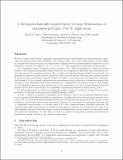| dc.contributor.author | Ames, Nicoli M. | |
| dc.contributor.author | Srivastava, Vikas | |
| dc.contributor.author | Chester, Shawn Alexander | |
| dc.contributor.author | Anand, Lallit | |
| dc.date.accessioned | 2011-08-31T19:10:14Z | |
| dc.date.available | 2011-08-31T19:10:14Z | |
| dc.date.issued | 2009-08 | |
| dc.date.submitted | 2008-11 | |
| dc.identifier.issn | 0749-6419 | |
| dc.identifier.issn | 1879-2154 | |
| dc.identifier.uri | http://hdl.handle.net/1721.1/65576 | |
| dc.description.abstract | We have conducted large-strain compression experiments on three representative amorphous polymeric materials: poly(methyl methacrylate) (PMMA), polycarbonate (PC), and a cyclo-olefin polymer (Zeonex-690R), in a temperature range spanning room temperature to slightly below the glass transition temperature of each material, in a strain rate range of View the MathML source to View the MathML source, and compressive true strains exceeding 100%.
The constitutive theory developed in Part I [Anand, L., Ames, N.M., Srivastava, V., Chester, S., 2009. A thermo-mechanically coupled theory for large deformations of amorphous polymers. Part 1: Formulation. International Journal of Plasticity] is specialized to capture the salient features of the thermo-mechanically coupled strain rate and temperature dependent large deformation mechanical response of amorphous polymers. For the three amorphous polymers studied experimentally, the specialized constitutive model is shown to perform well in reproducing the following major intrinsic features of the macroscopic stress–strain response of these materials: (a) the strain rate and temperature dependent yield strength; (b) the transient yield-peak and strain-softening which occurs due to deformation-induced disordering; (c) the subsequent rapid strain-hardening due to alignment of the polymer chains at large strains; (d) the unloading response at large strains; and (e) the temperature rise due to plastic-dissipation and the limited time for heat-conduction for the compression experiments performed at strain rates [View the MathML source]. We have implemented our thermo-mechanically coupled constitutive model by writing a user material subroutine for the finite element program [Abaqus/Explicit, 2007. SIMULIA, Providence, RI].
In order to validate the predictive capabilities of our constitutive theory and its numerical implementation, we have performed the following validation experiments: (i) isothermal fixed-end large-strain reversed-torsion tests on PC; (ii) macro-scale isothermal plane-strain cold- and hot-forming operations on PC; (iii) macro-scale isothermal, axi-symmetric hot-forming operations on Zeonex; (iv) micro-scale hot-embossing of Zeonex; and (v) high-speed normal-impact of a circular plate of PC with a spherical-tipped cylindrical projectile. By comparing the results from this suite of validation experiments of some key macroscopic features, such as the experimentally-measured deformed shapes and the load-displacement curves, against corresponding results from numerical simulations, we show that our theory is capable of reasonably accurately reproducing the experimental results obtained in the validation experiments. | en_US |
| dc.description.sponsorship | National Science Foundation (U.S.) (grant number DMI-0517966) | en_US |
| dc.description.sponsorship | Singapore-MIT Alliance | en_US |
| dc.language.iso | en_US | |
| dc.publisher | Elsevier B.V. | en_US |
| dc.relation.isversionof | http://dx.doi.org/10.1016/j.ijplas.2008.11.005 | en_US |
| dc.rights | Article is made available in accordance with the publisher's policy and may be subject to US copyright law. Please refer to the publisher's site for terms of use. | en_US |
| dc.source | Prof. Anand | en_US |
| dc.title | A thermo-mechanically coupled theory for large deformations of amorphous polymers. Part II: Applications | en_US |
| dc.type | Article | en_US |
| dc.identifier.citation | Ames, Nicoli M. et al. “A Thermo-mechanically Coupled Theory for Large Deformations of Amorphous Polymers. Part II: Applications.” International Journal of Plasticity 25.8 (2009) : 1495-1539. | en_US |
| dc.contributor.department | Massachusetts Institute of Technology. Department of Mechanical Engineering | en_US |
| dc.contributor.approver | Anand, Lallit | |
| dc.contributor.mitauthor | Anand, Lallit | |
| dc.contributor.mitauthor | Ames, Nicoli M. | |
| dc.contributor.mitauthor | Srivastava, Vikas | |
| dc.contributor.mitauthor | Chester, Shawn Alexander | |
| dc.relation.journal | International Journal of Plasticity | en_US |
| dc.eprint.version | Author's final manuscript | en_US |
| dc.type.uri | http://purl.org/eprint/type/JournalArticle | en_US |
| eprint.status | http://purl.org/eprint/status/PeerReviewed | en_US |
| dspace.orderedauthors | Ames, Nicoli M.; Srivastava, Vikas; Chester, Shawn A.; Anand, Lallit | en |
| dc.identifier.orcid | https://orcid.org/0000-0002-4581-7888 | |
| mit.license | PUBLISHER_POLICY | en_US |
| mit.metadata.status | Complete | |
